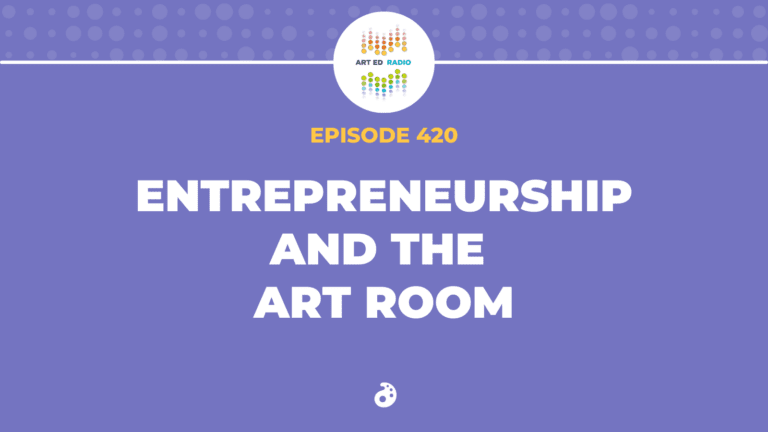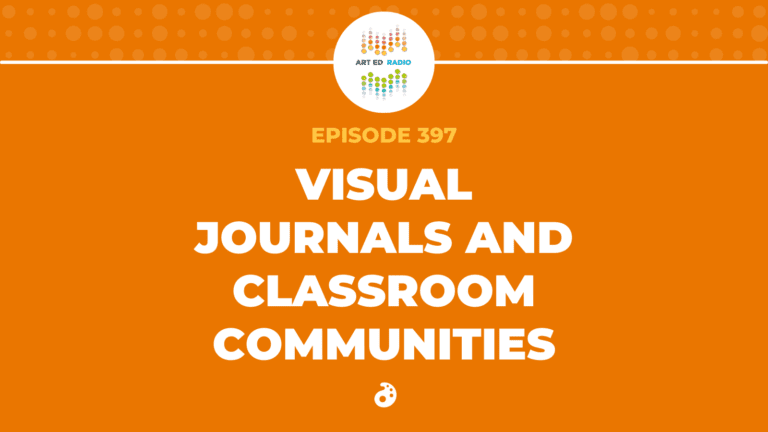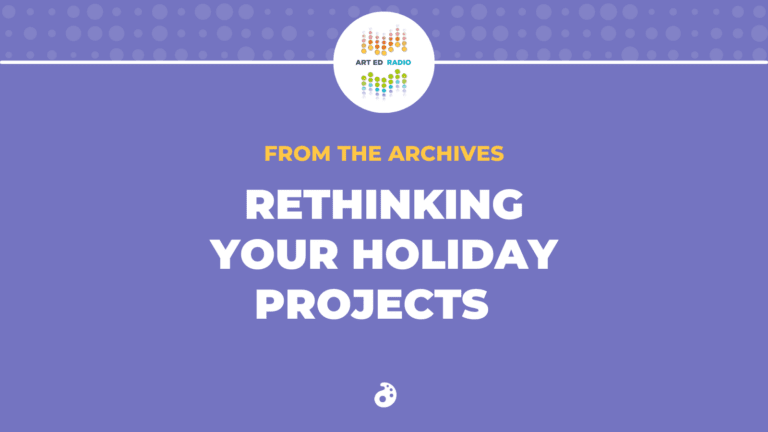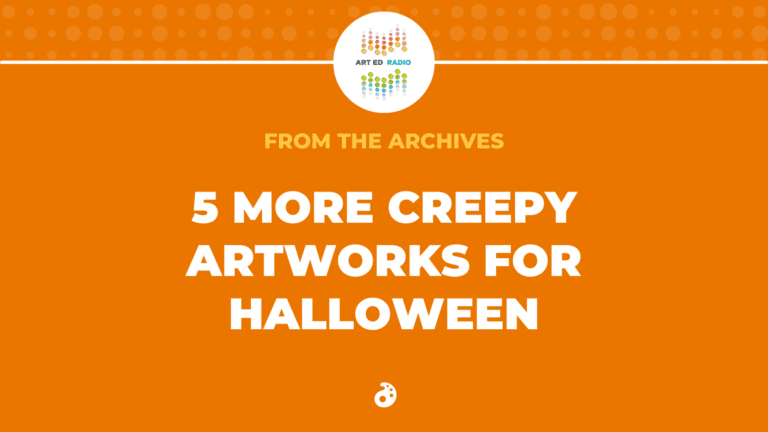A couple weeks ago, Andrew talked about elementary STEAM education with Tricia Fuglestad. This week, he’s back with a discussion on STEAM education at the secondary level with AOE instructor Anna Nuttall. They cover a lot of ground in the interview, including what a secondary STEAM curriculum can and should look like (4:45), what STEAM can offer that a traditional curriculum can’t (9:30), and the best ways to approach STEAM if you don’t have a lot of experience or knowledge (15:15). Full episode transcript below.
Resources and Links
- AOE’s Project Based Art Room graduate course
- How to Keep the Integrity of Art in STEAM
- 21st Century Attributes for the Art Room
- 5 Easy Ways to Gather STEAM in your Art Room
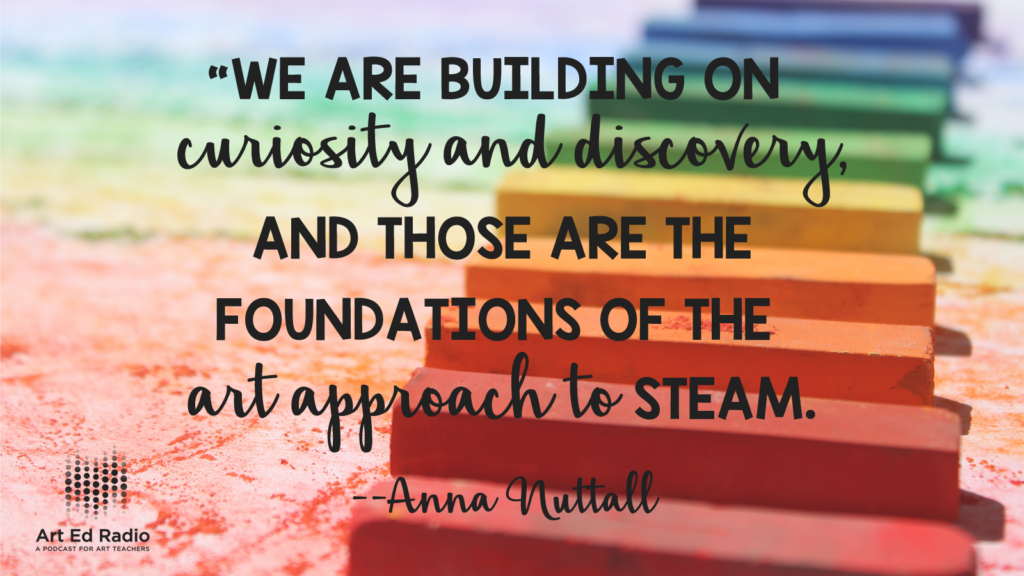
Transcript
Welcome to Art Ed radio. The podcast for art teachers. This show is produced by the Art of Education and I’m your host, Andrew McCormick.
A few weeks ago we had on the one and only Tricia Fuglestad to talk about all things STEAM education at the elementary level. I’m happy to be back on with the equally impressive STEAM education extraordinaire Anna Nuttall to talk about how STEAM education looks and functions at the secondary level. Anna is an excellent middle school teacher in the New Hampshire level and has been a long time adjunct instructor at the Art of Education and STEAM is her passion.
I used to think that I was big into STEAM and then I had a chance to sit down and talk with Anna and man, she blows me out of the water. Her approach and interest in science and how the arts can actually make STEM education work better is just awesome. You’re all going to really enjoy this conversation. Anna is just an absolute treasure trove of STEAM knowledge.
We’ve tried to gear these STEAM podcasts to teachers out there that are feeling the STEAM pinch. Maybe it’s something you want to do on your own or maybe it’s something that’s being put upon you. Maybe you’re like Anna and this will all just come naturally or maybe this whole arts integration into STEM is a bit of a stretch for you.
Whichever camp you fall into AOE’s project based art room is an awesome opportunity and an awesome class for you. In the class you’ll see connections in the arts and STEM, PVL, arts integration, maker spaces and you’ll connect with other great like minded art teachers out there. The project based art room is a three credit class and new sections start up every month. Head on over to the Art of Ed dotcom and check out this and all the other great classes in the courses tab.
After last weeks epic 30+ minute rant on drawing that Tim rolled out I think I’ll keep this short and sweet and get right into the interview. Hey Anna. Thanks for coming in today to talk.
Anna: Thanks. I’m really excited to be here.
Andrew: I’ve got to tell you, I kind of stumbled across a video of yours in the project based classroom that I was teaching for AOE and I’ve kind of become a big fan of your approach to STEAM education and it was nice for me to find another secondary STEAM person out there. In some ways I’m going to ask some of the same questions that I asked a few weeks ago to Tricia Fuglestad in our elementary STEAM podcast. One of the things that I’m really interested in, and I’m sure some of the art ed radio listeners out there are also interested in, is your evolution from an art teacher to then STEAM art teacher, or an art teacher that happens to infuse STEAM. Have you always been kind of a big science, tech, engineering and math and science person? Was it an easy adoption or has this been a long process for you?
Anna: That’s a good question. From the beginning my first year teaching, I started at the elementary level and was there for eight years. I think this is my tenth year at the middle school and I teach high school in the summers. Something that I was passionate about right out of the gate is integrated arts. Integrating any subject into the arts and partnering with classroom teachers and partnering with subject specific teachers. That kind of connection of art is a way of teaching everything in the whole wide world was something that I kind of already had wired in. That’s one of the reasons I get so excited about teaching and teaching projects.
The kind of evolution into the science and technology, engineering and math areas was also just part of that. Science was kind of still my big passion as far as doing a lot of science in art. Technology has definitely as it’s become more available to me and grant writing and all of that as well, has certainly factored in and math and engineering as well. It kind of just started as integrating arts in general and doing a lot of integrated projects and then just evolving into a lot of STEAM, now that it has a name.
Andrew: Do you think, one of the things that I sometimes think about if people assume that as a STEAM art educator or a STEAM educator that you do wall to wall STEAM or are you sprinkling some projects sporadically through then what we might consider a more traditional art curriculum?
Anna: It varies. Right now I do a few units per year with each grade level that are pretty strong STEAM units. Then in the summer I do a partnership program funded through the National Science Foundation, with Dartmouth College and an art center near there where we bring kids into the microscopy labs at Dartmouth, the research-bio labs and get them on the half million dollar microscopes and all that exciting stuff. My program at my full time school is not a full STEAM program. I still definitely … another passion of mine is doing community based project and getting kids out into the community and the community into the classroom. That’s kind of my other love so it’s kind of a mix.
I am trying to move more building in more units of STEAM. I’d like to eventually roll that over into an extracurricular, pretty full fledged, year long, extracurricular club. We have an art club and we’ve certainly done some STEAM projects but I’d like to get really kind of a full steam ahead afterschool program going as well.
Andrew: I think it’s impossible to have a STEAM conversation with other STEAM educators and someone not bring up the full steam ahead pun. It’s just a given.
Anna: I know it’s hard.
Andrew: It’s so hard not to do that. I wanted to ask you about the different age groups you teach. It sounds like you’ve got high school kids in the summer as an enrichment thing. Middle school, Jr. High, is such a hodge podge of grades depending on the states and the districts. When you say that you’re a middle school teacher what age groups are we talking here?
Anna: We have 6th, 7th, and 8th grade here.
Andrew: One of the things I’m kind of curious about, you do some STEAM project at the 6, 7, 8 level. You do some STEAM projects with your high school kids where you work with the college. What do you think are the big differences between those two age groups but then even also secondary kids to elementary kids if we’re talking about STEAM throughout the whole K12 curriculum?
Anna: I honestly don’t see a big difference. I really don’t. I always see art as a way of teaching. It’s certainly a subject in itself of study but it’s a way of teaching anything. I think that goes K to 12. You can get kids with magnifying glasses out in the middle of a muddy marsh looking at amazing things. Taking field notes, doing scientific investigations, hypothesizing, all of those processes that scientists do, engineers do, you can use the technology. You can bring your field microscopes out there. You can bring things back into the classroom and do some digital photos. You can do that with elementary school as well.
That was something that we used to do when I was at the elementary level was a lot of partnerships, especially with the science programs, as well as with math. That was another big one at the elementary level that was a good partnership. It enriches their curriculum as well. I would just ask, “Hey what units do you guys find that you’re struggling with the most and how can I help roll that into something that I’m doing?” It’s easy for me to roll something into my curriculum that hits what they’re struggling with or vice versa really. It’s kind of a win-win but I think it expands the gambit. I think it’s K through 12 and you can do it. It can be simple or complex, it could be short or long and obviously age appropriate but I think you could do it at any level.
Andrew: Right. You might have a similar idea, like crystal structures. What are high school kids going to do with that sort of a lesson plan versus an elementary plan. It might look different but they’re still learning some things.
Anna: Right. I think that thinking process is the same process. You’re still teaching them to observe, investigate, experiment, discover, interpret so you’re still doing a lot of that. Synthesize that information with their experience and hopefully generate something new from it. I think just that process is very similar, K to 12, but obviously your learning targets and objectives are going to be different.
Andrew: One of the things I think about as STEAM has gotten bigger and bigger and more and more teachers and districts are thinking about ways to adopt it and infuse it. I just think about like why. Why would an art teacher want to take this on? I want to ask you, I know I could speak to this and I’ve taught more traditional principles and elements sort of curriculum when I first started. Then I think about what do our kids get out of a more STEAM curriculum? What do you think that your kids are getting out of this that they may not get in a traditional art classroom?
Anna: I think it’s just it’s a way of making their environment and what’s around them even more exciting. Science is you’re surrounded by nature, you’re surrounded by your environment, you’re surrounded by all of the things that are science. You’re a piece of science as humans. Studying that, we get to study that through a difference lens. They’re studying all the human body systems in 6th grade right now. We can study then in art but we’re going to interact with them with a whole new multisensory way. It can make that content that much more exciting and engaging.
From the art perspective we can do sculpture, we can do watercolor, we can still hit all of those elements and principles and I can still hit all of my district, state, and national core standards. I’m just changing up the subject matter to be something that is exciting to them and that they can sometimes bring in. If I’m tagging on a grade level target then they get to bring in a little bit of prior knowledge to it and that excites them that they’re bringing that to the table and we’re all learners in the room and we’re sharing.
Vice versa if I’m the one who’s bringing it to the table they’re going to hear it again in their classroom a little bit later, they’re going to be like, “Hey I know something about this. We did this thing.” It kind of just feeds off each other and it’s exciting. I think it kind of brings an added energy to it. For me, like I said, I might be teaching paper mache and we can build in a STEAM subject as our study. It’s so flexible I think that’s what I love so much about teaching art is that you can morph it into anything.
Andrew: That’s right. I think we do that better than anyone else. The other thing I think art teachers do better than probably anyone else in the building is we’re just a natural at making things be hands on and project based and immediate. I’ve always thought that, you know I hear kids sometimes grumble about how they don’t like science class and they don’t like math class. I don’t necessarily disagree with them because I don’t think kids like learning about science necessarily. I think they like doing science and they like playing with science and they like experimenting with science.
In our buildings there’s no one that that comes more natural to than the art teacher. We can be a great resource like you said to kind of work cross disciplinary or by integrating the arts. I actually have to take exception to one of your words and call you out on something in a nice way here. The word study, like we can study science, we can study math. That word with our students has such a negative and boring connotation like, “I can study for my test or I can study about math.” You’re right. In the arts we learn about it but we do it by playing with the science or experimenting with the science or creating art with the science.
Anna: Absolutely. You’re building on curiosity and discovery and those two things are the foundation of the art approach to science or technology or engineering and math. You’re not just following directions. You’re choosing and you’re creating your own direction based on your own experiences that you’re touching, you’re feeling, you’re investigating, you’re looking. You’re kind of creating your own trajectory in the art room which is what keeps it exciting and kind of kicks off their intrinsic motivation to learn. I agree, study definitely has a bad wrap but maybe we can give it a better wrap.
Andrew: Yeah totally. Study could encompass more hands on experimentation, playful investigations. Not just memorize these facts, write them down, think them into your brain. That’s totally boring. One of the things that I love about STEAM people, I definitely get the tenant that is most attractive to you in STEM is science. I think a lot of people it’s maybe the engineering or the technology side. I think it’s really great, your interest in science, and I have kind of an unusual question for you, one that I didn’t think I was going to ask. I’m just imagining a listener out there who’s like, “I don’t like science, I never had a great experience with science. I don’t like math, I’ve never liked math. I don’t think like an engineer.” Do you think that there are art teachers out there that despite the fact that they’ve never really glommed on to STEM in their own learning, could actually run a STEAM curriculum despite all of that?
Anna: I think absolutely. I guess I would start with I think that there’s a lot of folks that thing they’re not science, technology, math people as a big catch term when in fact they actually are. Science, one of my passions is digging into plant biology. We’re digging into plant cells and looking at all the different parts of plants, reproduction of plants and all these things. We’re looking at some crazy stuff under the microscope. If you even like flowers, as an art teacher, if you love painting flowers, you can just take it one step deeper and say, “Hey. Okay what is the material made out of for this flower? How does it generate? How does it grow? How does it reproduce?” You can just dig deeper into something that you’re already interested in.
If you love radial symmetry you’re digging into math. You can just dig a little deeper. Start with an in that does attract you. The technology part, the science and technology part, so much these go hand in hand so easily, at least in my mind. The technology doesn’t have to be you have a whole computer lab. I think that’s a misconception is technology can be quite simple and still be a foundation of technology. I think there’s entry points for just about anybody. Maybe sometimes I think the STEM factor gets a bad wrap. People assume it’s math and computers and it’s a limited view of what that means. Really it’s so, so broad.
Andrew: Well and that could be that sort of cyclical collaboration. We can teach STEM teachers who are kind of in a rut with how to make things more hands on. At the same time if there are art teachers out there who like, “Boy I’ve been tasked with getting more STEAM into what I do,” go ask your science teachers, especially if they’re good ones, your math teachers. Say, “Okay I’m into this.” Like you said whatever you’re into. “How do you see me making that more science-y or more math-y. Also I’ll handle the art side.” I think there’s some ways to do it.
I want to switch gears just a little bit and ask you, you and I can both get each other pumped up for STEAM and it’s an easy sell for us. I think about the teachers out there who maybe aren’t as on board. I’m sure one of the things that they can think about are what are the trade offs? If we talk about there’s a traditional classroom and there’s a STEAM classroom. In your experience have you found there to be some big trade offs? Were there some things you had to let go? Were there some obstacles like time, money, and storage or has it been smooth sailing the whole way?
Anna: I think that’s a good question. I think that it’s like any other project planning that you’re doing whether you’re going to focus on Picasso and cubism and dissect that you can focus on any STEM related topic and dissect it in a very similar way. It’s a programming thing that I think ultimately you have the flexibility. It’s not something that I had to add on. The original development of the lessons, sure that takes some extra time to just dream up a new lesson. Really beyond that I’m not doing a ton of … I’m not adding it onto my existing curriculum. I’m working it into it. We’re doing watercolors, we’re learning value, we’re doing observational drawing, and we’re also doing STEAM. It all kind of just can get integrated into one. It’s not a matter of just adding time.
Money, doesn’t need any extra money. If you have a giant technology dream, you might not have the resources or the technology to do something super crazy. Again I don’t think money as a prohibitive factor for doing STEAM programming. You can use engineering if you’re working with kinetic sculptures. You can use all recyclable materials if you want, if you need to. You can source from your whole community and get donations of materials to build with. In fact the limitation of materials pushes your creativity. If you’re really looking for innovative thinking and critical thinking and problem solving, which is one of those common denominators across STEAM subjects, that can happen with very, very limited resources and in fact I think it almost happens better with that. If you have to build something out of only triangles you’re going to push your creativity further than it could go if you had all the materials at your disposal that you need.
I think it’s pretty doable. Storage, I always have a storage problem. Nothing new there. Again you can plan for that. You can plan to do small projects, you can plan to do big projects. I find that STEAM is just like any other type of project that you’re planning in terms of it’s flexibility and your meeting the standards and you build it. Start with a seed of an idea that relates to a STEAM related subject and see how you can build it and more it into an area that you’re already doing as far as having standards to meet.
Andrew: Yeah. I agree with that. I often think about obstacles as like, obstacles are just totally relevant. If you want something bad enough you’re going to blast over storage issues. One that I have had to battle with is I do think that my STEAM projects take a little longer. It’s just been the trade off of if I’m going to do one or two big STEAM multidisciplinary project, I may not get the quantity of different projects out there but that project can be so encompassing it’s like two or three projects in one.
Anna: Absolutely.
Andrew: I want to just wrap up with a two for one type of question. I know the struggle for teachers in April it’s real man. Those students start feeling itchy for summer break. Maybe from your experience for anyone out there who wants to try a STEAM project and they haven’t done one all year, do you have some go to favorite lessons? Some things that people could adopt right away, and launch a project that’s really engrossing and really gets kids excited about this stuff?
Anna: As far as projects that are completely doable. Even something like observational drawing which hopefully they’ve hit at some point this year already. Even something as simple as that but shake it up and if you’re searching up photos and doing your slideshow and having photos available of microscopic views of things, whether it’s a cross section of a blade of grass, which you’d be surprised is full of smiley faces which makes them all crazy with excitement. There’s some really weird stuff out there once you look under an electron microscope. If you’re looking at images just from online, that anybody can get, you can pull together a slideshow in no time. You’re pulling up electron microscope pictures of insects, they’re going to go crazy. Then you have a project where you’ve got electron microscope images of insects.
There you do observational drawings of those, and then they get to fill in that they’re taking over a city or they’re driving in the car with them. You can take it into fun directions and get kind of crazy with it and it could be as simple as a drawing project. They got to investigate something from a whole new perspective. They got to see something they can’t see with the naked eye. They’ve learned about what an electron microscope is. That kind of think you’re building in technology, even though they might not have that microscope you’re giving them the view as if they did. It’s exciting and it’s simple, it could be pencil drawings with value. It could be as simple as that. I think it can be, you can make steam as simple or as complicated as you want. Mine, like you, a lot of them can go long if I want to do that. I’m also hitting a lot of different things along the way, a lot of standards along the way.
Andrew: Anna I want to get you out of here on this. For people who listen to the art ed podcast a couple of episodes. Every once in a while I ask questions of either Tim or a guest that validates my own sanity or lack thereof or tenuous grasp of because I want to make sure I’m not the only crazy one that has this idea. I think that STEAM education people, STEAM teachers, can have just pipe dream projects. Big projects that they were just thinking big and then for whatever reason reality snaps them back down to earth. Tell me that you have some crazy pipe dream projects and I’m not the only one.
Anna: I’ve got several but they’re all going to happen. They’re not going to hit the ground. I think the most recent one is probably, I want to have the kids collaboratively figure out how to design sustainable life and food sources but make an actual space station to do it on. I want them to construct a faux space station and then they have to do all the research and looking through the microscopes and learning about plants, plant reproduction, all that sexy science and how ethylene works. These are things that I’ve worked with them in the summers on and we’ve build giant protein chains that are 40 feet long and we’ve done amino acid weirdness and all that kind of crazy stuff. I want to do it on the most artistically strange, amazing, space station so that they are growing their own food but obviously not really. We’re going to make it very artistic food, and build a space station that could actually sustain a sustainable food source.
Andrew: Okay now hold on. Now I feel bad that I asked because my pipe dreams are really lame compared to yours. You’re like alternate life forms and things going into orbit.
Anna: There will be aliens involved for sure. It’ll go fantasy Star Trek at some point for sure.
Andrew: Like I just want to build a catapult and chuck pumpkins and make pumpkin pies with it, I think that would be amazing.
Anna: We did that with water balloons filled with tempera paint and I tell you, those interns dressed in Tyvex suits never had so much fun.
Andrew: That’s cool. One of these days we’re going to have to get together again and share notes on our pipe dreams and we’re just going to have the craziest curriculum ever the world has ever seen.
Anna: I think that’s a great plan.
Andrew: All right thanks Anna. Thanks for coming on.
Anna: Thanks so much for having me.
Andrew: Holy cow. Anna’s pipe dream is to build a space station. That’s awesome. I think if you put Anna and I together for an extended period of time our curriculum would get real weird, real quick and it would be awesome. I love those big ideas that she’s coming up with and those connections to science that she just naturally finds. Much like at the elementary level STEAM education doesn’t have to be something “new” that we do. It’s something that with a few small tweaks and better explaining, stuff that we already do. We can sell and make the art connection to STEM more visible and more meaningful.
We are the people that do PBL and cross-curricular education like STEAM better than anyone else in our school building. I almost said this during the talk with Anna but I kind of held my tongue but I’ll say it here and now. We are the administrators of creativity. We are the most important teachers in the building and even in the district. Of course I’m biased but come on, we all know it’s true.
Art Ed Radio is developed, produced and supported by the Art of Education with audio engineering by Michael Crocker. For fans of the podcast out there you can do us a favor and give us a ranking or glowing review on iTunes as this is totally what helps us find new listeners. As always new episodes of Art Ed Radio are released every Tuesday and additional content can be found under the podcast tab on the Art of Ed dotcom. All right thanks for listening.
Magazine articles and podcasts are opinions of professional education contributors and do not necessarily represent the position of the Art of Education University (AOEU) or its academic offerings. Contributors use terms in the way they are most often talked about in the scope of their educational experiences.
